610 Search Results for visual support
August 13, 2013
by Robin Parker -
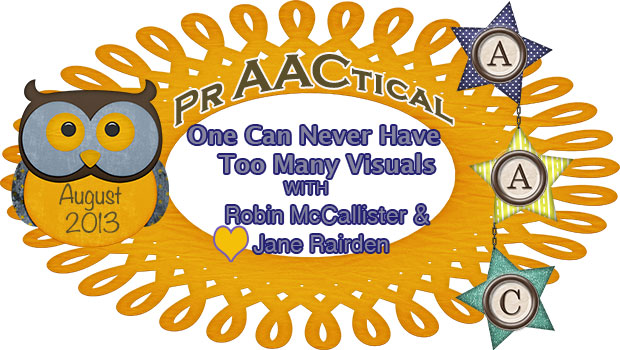
Today, we are so excited to have our new friends from the awesome blog lunchbuddiesplus sharing how and why they incorporate visual supports into their sessions. In their lunchbuddiesplus group sessions, the focus is on social skills and they find that visual supports make a huge positive impact. So as you get ready for back to school, think about the visual supports that will help make your goals and activities go smoothly. Robin McCallister is a Speech/Language Pathologist working at Mary Munford Elementary School in the Richmond City School district in Richmond, Va. She has 36 years of experience in the public schools. Currently, she spends most of the school day working withchildrenwho experience autism. She especially enjoys the social skills groups known at Mary Munford as “lunch buddies”. Visuals are a big part of social skills coaching and Robin knows that one can never have too many visuals! You are invited... [Read More...]
July 22, 2013
by Robin Parker -
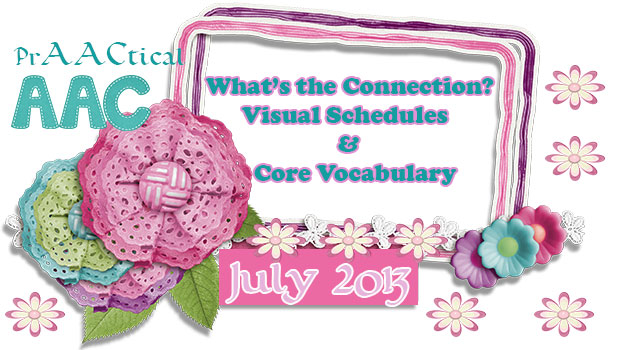
Because it seems there has been a lot of emphasis on core words and visual schedules over the past couple of months, we wanted to highlight a particular resource titled: Visual Schedules to Expose & Reinforce Core Vocabulary by (the great) Gail Van Tatenhove. This resource can be found on the Minspeak website which shares excellent (& free) comprehensive AAC information for everyone. You can search by categories and get fact sheets, communication boards, curriculum supports and more. AAC users, families, & caregivers Teachers and therapists Academicians & students Teaching Plans & Materials Pixon Project Resources Try out some of the ideas from the Visual Schedule/Core Word Resource or something else and let us know what you think.
July 11, 2013
by Robin Parker -
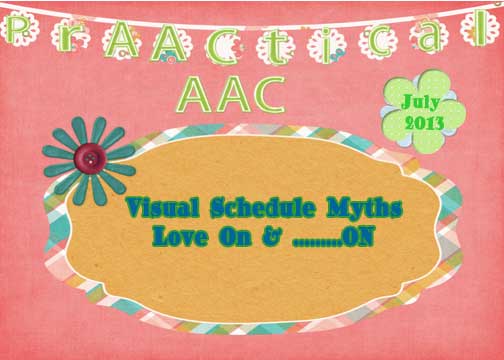
There are many myths about visual schedules for learners with special needs. Those myths multiply for older learners as well as for learners who are thought to have higher or lower skills. It is amusing to us (in a not really funny way) that these myths don’t typically extend to the SLP’s, educators, or other professionals and THEIR schedules/day planners. We have heard a lot of visual schedule myths in the last couple of weeks, which means the topic may need some re-visiting. Here are some TRUTHS about visual schedules. Please share if these myths come up in your area. Visual Schedules Increase INDEPENDENCE– Independence is supported when you can follow a visual schedule and do not need another person with you to tell you the steps to complete a day or a task. Independence is also facilitated when you can check for yourself when an event is happening rather than... [Read More...]
June 22, 2013
by Robin Parker -
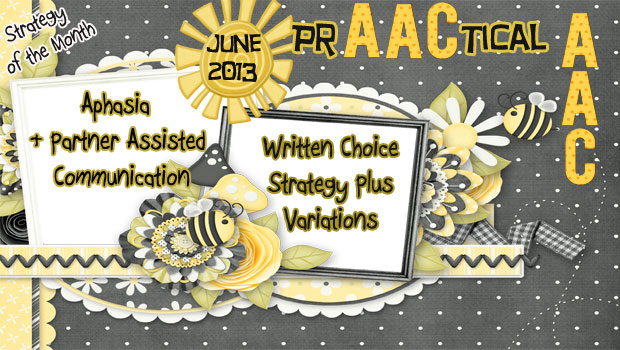
This month, we have enjoyed writing about communication strategies for aphasia. Partner supported communication is the platform for many of the effective techniques we use to help people with aphasia initiate, maintain, or terminate communication and conversation. We have talked about assessment strategies, communication books, and alphabet & topic supplementation. Now it is time to discuss the written choice strategy. The written choice strategy is fairly easy to implement, can look natural, and can result in seamless detailed conversation. Written choices are provided in the context of conversation and are displayed in an organized manner. What is It? The written choice strategy has the partner/facilitator generating written key-word choices that relate to the conversational topic. The written choices can be paired with text, pictures, drawings, symbols, and natural speech. The partner/facilitator writes possible answers to conversational questions in list form. The conversation is extended as continued written choices are offered... [Read More...]
June 3, 2013
by Robin Parker -

There are many strategies to support communication and conversation for individuals with significant aphasia. Conversation is about connecting with people. We engage in conversation about interesting and relevant experiences to help with connecting. To best connect and be part of conversation, there needs to be comprehension and expression from each communication partner. With aphasia, there is difficulty in these language areas, but it is not that language is lost, it is that it needs to be accessed differently. These quick start tips will support accessing conversation and connections. Write or Draw Key Words– When you are talking, write key words to support your spoken language. Gesture Key Words– When you are talking, supplement spoken language with gestures to illustrate a main point Show Related Photographs or Remnants– While you are talking, use photographs or some remnant of the an experience or event you are talking about. Written Choices to... [Read More...]
May 9, 2013
by Carole Zangari -
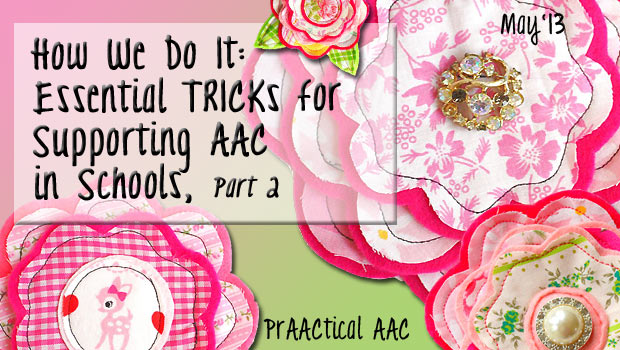
Today we welcome back 3 SLPs from the Orange County Public School (OCPS) AT team, Cathy George, Marcia Sterner, and Marcia Piersall. They are part of a very active and competent AT Team that supports over 700 students with dedicated AAC devices. It is no surprise that they’ve come up with a list of 5 essential TRICKs that they count on to help them support these students and their educational teams. You can read about the first 2 TRICKS, Try It and Resources, here and download some of their terrific resources. Today, we learn about the rest of their TRICKs: Information, Can’t Live Without It, and Kick It Up A Notch. Give Me Five: Essential TRICKS, Part 2 INFORMATION about the student Student interests What systems previously tried What tasks s/he is struggling with Trial data sheet– Communicative competence organizer CAN’T LIVE WITHOUT IT: In addition to AAC devices, these... [Read More...]
May 8, 2013
by Robin Parker -

It’s PrAACtically Mother’s Day and we are thinking about gifts and activities that promote communication, language, & literacy. Here are 5 activities that are fun and interesting to plan for and do interactively. In the end, there will also be a tangible and/or intangible gift for mom. Enjoy and please share any additional activities that you have done or seen that you think are great. Visual Supports to Support Conversations with Moms-Thanks so much to Joel Shaul at Autism Teaching Strategies for creating this great visual support that helps support meaningful conversations with mom. Saying I Love You On Mother’s Day– Ideas for teaching communication of “I Love You” for beginning communicator. Mother’s Day Word List– Ideas for using this Mother’s Day Word Bank to create a poem, story, or more.. Words, words, and more words for conversation about mom. Your Special Chef– Use this picture recipe and lesson plan... [Read More...]
March 24, 2013
by Carole Zangari -
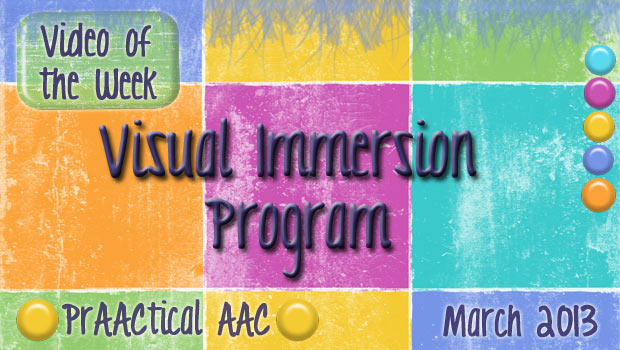
In this week’s featured video, we go to the AAC-RERC to get an in-depth look at a systematic approach to visual supports for people with ASD. Howard Shane and Meghan O’Brien explain the basic premise of the Visual Immersion Program’s approach, the communicative functions it is designed to support, and the key principles and procedures. The webcast is broken into three parts, with accompanying slides and transcripts.
February 28, 2013
by Carole Zangari -
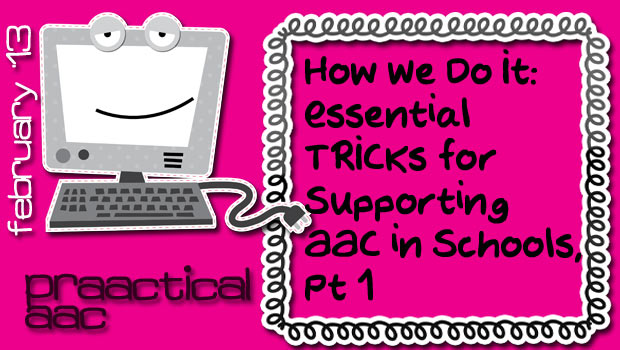
When I first moved to Florida almost 20 years ago, there was a plethora of AAC trainings for special educators, school-based SLPs, and other related service personnel. The AAC professionals in the Orange County area could always be counted on for top-notch information and engaging presentations that kept all of us learning and growing. Florida since moved into a different model for professional development in AT and I am still mourning the loss of access to this fabulous team. We are so lucky that they agreed to share some of their ‘Go – To’ resources with us in this post. The OCPS AT Team has 5 TRICKS to share with us and all of them are very prAACtical. In this post, they share the first two (stay tuned for the other 3 TRICKS in a future post). Get ready to check out their prAACtical ideas and download some of their... [Read More...]
February 1, 2013
by Carole Zangari -
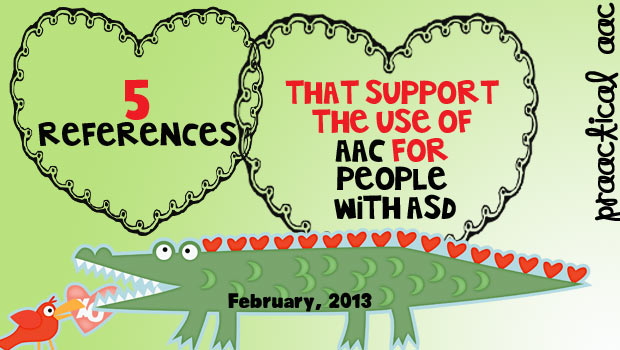
We occasionally get asked to provide empirical supports for some of the AAC tools and strategies used in our clinical work and teaching. Here are five references that we wanted to pass along. Ganz, J.B., Earles-Vollrath, T.L., Heath, A.K., Parker, R.I., Rispoli, M.J., & Duran, J.B. (2012). A meta-analysis of single case research studies on aided augmentative and alternative communication systems with individuals with autism spectrum disorders. Journal of Autism and Developmental Disorders, 42,1, 60-74. Systematic review of 24 single subject experimental design (SSED) studies investigated the impact of AAC interventions and concluded that aided AAC interventions had positive effects on communication and behavior skills. Although all picture-based AAC systems were effective, learners did best with SGDs or PECs. Checkley, R., Reidy, L., Chantler, S. Hodge, N., & Holmes, K. (2012). “Black white zebra orange orange”: How children with autism make use of computer-based voice output communication aids in their language... [Read More...]









